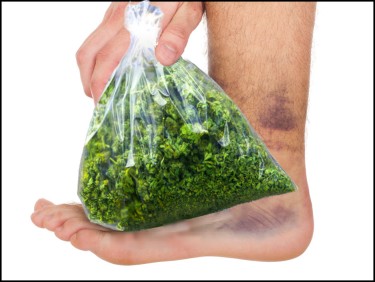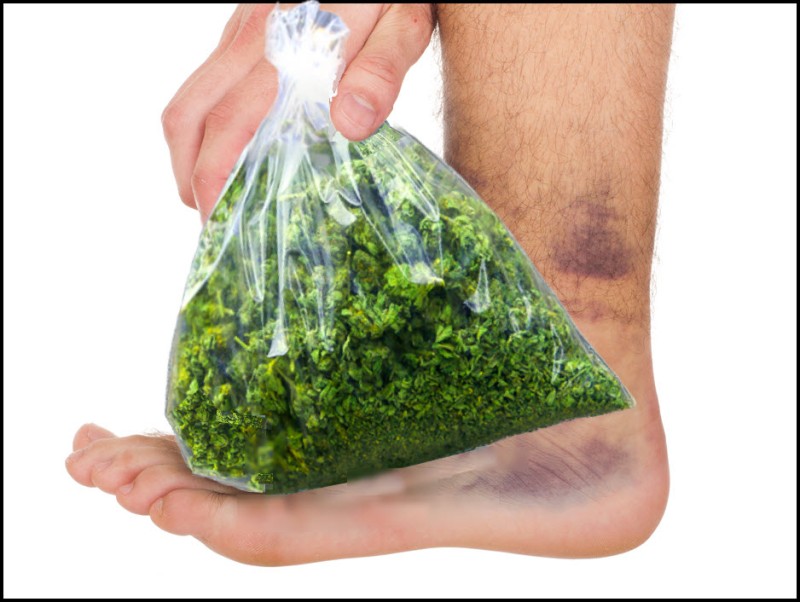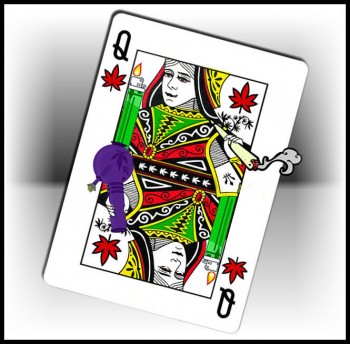
Using ice or a cold compress is one of the most famous first-aid treatments we know for an injury or sprain.
It’s usually best used right after the injury happens. This involves an ice pack or ice compress placed on the affected area, designed to reduce inflammation and numb out any pain while reducing swelling. Exposure to the cold has been known to decrease circulation and constrict the blood vessels.
However, using cannabidiol (CBD), the non-psychoactive component of marijuana, may be more effective (and practical) for treating sprains and injuries. In fact, it can take the place of ice completely. CBD is simply more convenient since you can carry topicals for spot treatment as well as oral CBD products for when you have an accident. It also has the added benefit of being free from THC, which is an advantage for athletes.
Sports injuries can also happen when running or jumping on hard surfaces, wearing improper shoes, doing the wrong exercise techniques, poor flexibility, old injuries, or doing the same sport all year round among others.
Common Sports Injuries
There are many different types of sports injuries where ice is usually used as first aid. We can experience them when doing a fitness routine though they are more common among athletes, but the truth is that they don’t choose – these can happen to anyone. In these cases, CBD can replace ice.
Sprains: Anyone who does sports can be prone to sprains. It occurs when a ligament (in some cases, two ligaments) is torn, stretched, or twisted. Ligaments are long tissue bands that wrap around joints or link bones to one another. The most common site for sprains is in the ankle and knee, which leaves the patient in pain and suffering from limited movements.
Strains: Strains are muscle injuries. This can happen when muscles are over extended or overstretched during exercise. Strains most commonly occur when one changes directly abruptly, while jumping, running, or lifting.
Tennis elbow: For golf and tennis enthusiasts, tennis elbows are common. This affects the outside of the elbows, resulting in inflammation and in some cases, chronic pain.
Runner’s knee: Individuals who do marathons or triathlons involving running and biking may suffer from runner’s knee. This injury is caused by repetitive motions, resulting in pain and swelling under the kneecap area which is known as the patella.
Achilles tendon injury: The Achilles tendon, which connects the heel to the calf muscle, is the biggest tendon in the human body. Injuries here can occur during periods of extensive running, and pain is felt when the patient stands on their heel or toes, or when the ankle is being stretched.
Why CBD For Sports-Related Injuries Works
A sprain or injury is a major inconvenience every time it happens. Whether you are an athlete or not, recovery and healing at the soonest possible time is critical, not to mention the fact that it’s also extremely painful.
For athletes, the reliance of opioids, ice and other treatment mechanisms were used at the first sign of pain and injury though opioids are never recommended because it’s addicting and has seriously negative side effects which can also be fatal. Using topical CBD for pain relief and for fighting inflammation is a better option since it activates the endocannabinoid receptors in the affected area to help control stiffness and pain. In addition, CBD interacts with the CB1 and CB2 receptors that can reduce the inflammation and pain caused by irritations and sports injuries.
This is important for anyone who frequently exercises, does sports, or simply is prone to more injuries because CBD shortens the recovery period while ensuring you are still comfortable.
“Sports injuries most often involve either significant inflammation response or mild micro-traumas,” explains Dr. Andrew Kerklaan of Dr. Kerklaan Therapeutics, to Aaptiv. “Because of CBD’s anti-inflammatory potential, it may be useful in a myriad of symptoms – from mild everyday aches and pains to minor injuries.” He also explains that CBD can help individuals recover from common injuries caused by exercise. “These will all trigger inflammatory responses and therefore CBD may have potential to help in the recovery process,” he says.
There are dozens of studies too, which tout the analgesic benefits of CBD. One study in 2020 revealed that CBD is beneficial for chronic pain while improving inflammation and sleep. Then in a 2018 review analyzing 132 studies in Frontiers in Neurology, researchers discovered that CBD was effective in treating inflammation, reducing pain, and improving mobility in individuals with multiple sclerosis. “It is anti-inflammatory, antioxidative, antiemetic, antipsychotic, and neuroprotective,” wrote the study authors.
How To Use CBD For Injuries
There are many CBD products in the market that work well for injuries. For muscle and tissue-related injuries, using topical products is a fast-acting and effective way to enjoy localized relief. Topical products act faster than edibles. However, for those in serious pain, tinctures and sublingual drops are recommended since they are the quickest of all consumption methods.
CBD can also be ingested as an oil, while CBD infused ointments and creams can be applied to the affected area several times throughout the week while you recover.
CBD can also be used before and after an exercise for preventive care.






